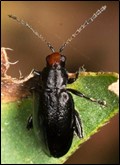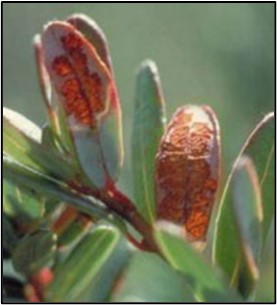Red-Headed Flea Beetle Showing Up at Marshes

Red-headed flea beetle (aka cranberry flea beetle; Systena frontalis) adults (Fig 1) started showing up at some marshes in the second week of July. It is important at this time to monitor adult populations and to watch for extensive feeding injury. Feeding injury may be more cosmetic than detrimental to the cranberry plants in many cases.

Damage symptoms. Adults feed on foliage (Fig. 2) and occasionally on the surface of cranberry fruit. Severe adult infestations can lead to skeletonization of leaves (i.e., loss of the tissue between veins) and death of uprights. Heavy feeding by adults can also impact bud development, leading to yield reductions the year following an infestation. Adult populations and damage are usually patchy. Larvae feed on cranberry roots and underground runners. When infestations are severe, larval feeding can lead to girdled roots and vine death.
Life cycle. In Wisconsin, females deposit single eggs into the soil in late summer through early fall, and the eggs serve as the overwintering stage of the insect. In the spring, the eggs hatch, and larvae feed on roots from June through August. Larvae eventually pupate and adults begin to emerge in July and are present through September. In Wisconsin, red-headed flea beetle has one generation per year.
Monitor by using a sweep net to capture adults. Be sure to sample thoroughly across different areas within a cranberry bed to account for the patchy distribution of adults. There is no established action threshold for flea beetle in cranberry. However, the University of Maine Extension recommends taking action if you find more than 15 adults per 25 sweeps in a cranberry bed.
| Product Name | Efficacy |
| Actara | +++ |
| Assail | ++ |
| Venom | +++ |
| Lorsban, Orthene | ++ |
| Diazinon, Imidan | +++ |
| Sevin | ++ |
| Altacor, Exirel | + |
| Delegate | + |
| Azera (OMRI) | ++ |
Management. At this time, biological control using entomopathogenic nematodes to target flea beetle larvae in the soil is the most promising strategy and is being evaluated by Shawn Steffan’s lab and grower collaborators. If scouting indicates significant numbers of flea beetle adults, you may consider using insecticides to control them. Products that are effective against flea beetle adults include neonicotinoids (e.g., thiamethoxam, acetamiprid, dinotefuran), diamides (e.g., chlorantraniliprole, cyantraniliprole), spinosyns (e.g., spinetoram), organophosphates (e.g., chlorpyrifos, phosmet, diazinon) and carbamates (e.g., carbaryl). In organic production, our insecticide trials suggested that Azera which contains the active ingredient azaditechtin and pyrethrins had good efficacy at reducing flea beetle adult populations. Refer to table 1 for more information on the efficacy of commonly-used products in cranberry. When using insecticides, it is important to rotate active ingredients from different chemical classes, which have different modes of action and thus different IRAC codes, to help delay the development of insecticide resistance. Please be sure to read the labels and to check with your handlers before using any pesticide.
Happy growing season!
This article was posted in Cranberry, Insects and tagged Christelle Guédot, Cranberries, Cranberry Flea Beetle, insect control, insects, red-headed flea beetle.
